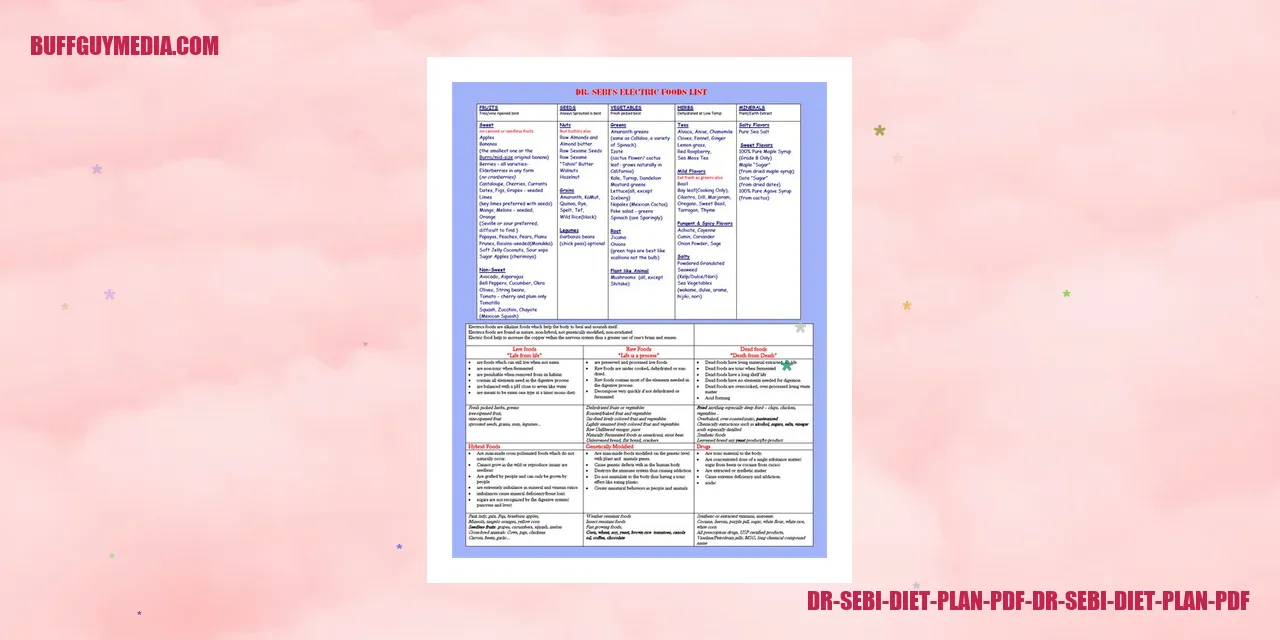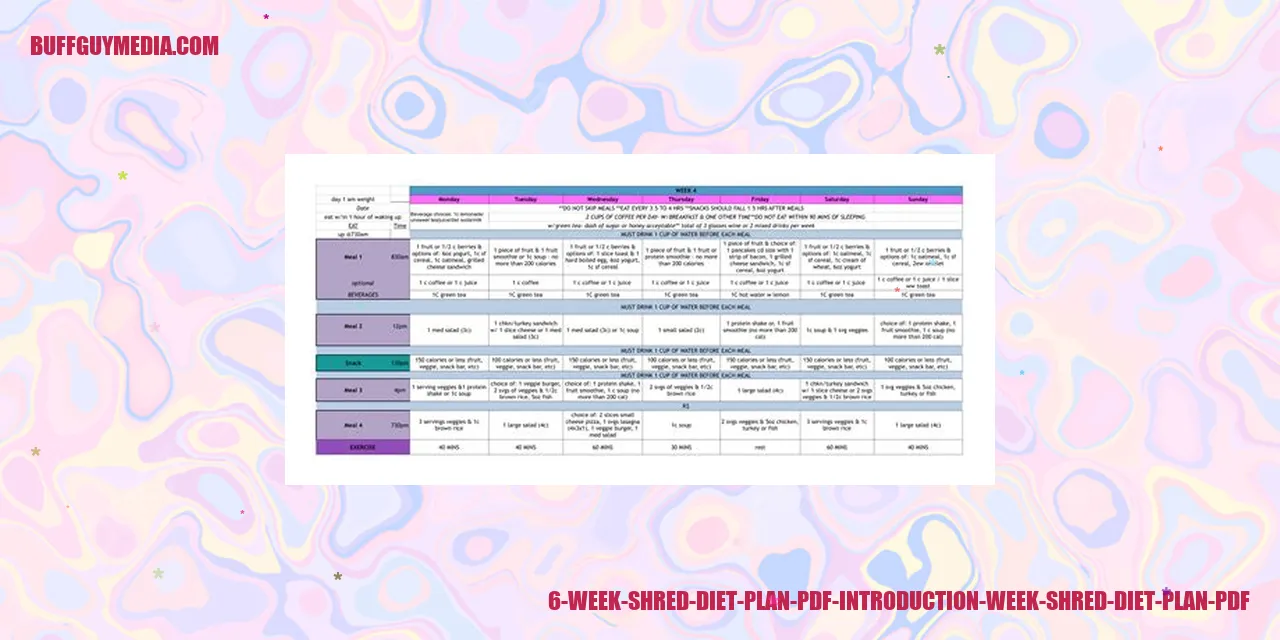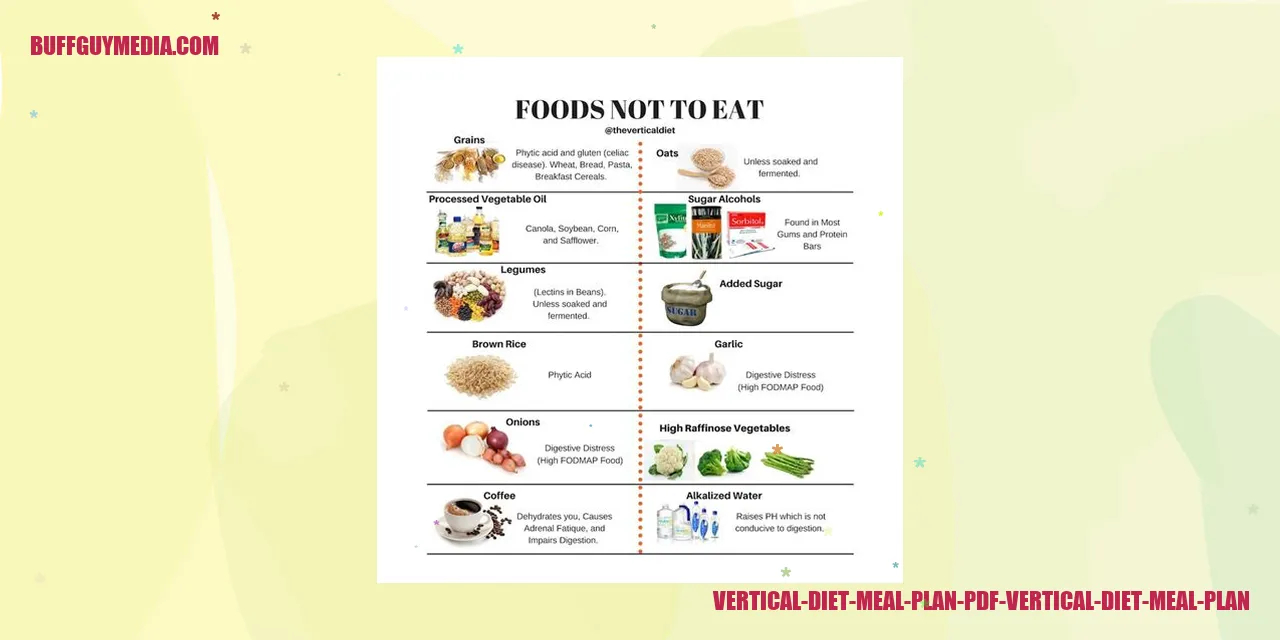Carb Cycling Diet Plan PDF: Your Complete Guide to Effective Weight Loss
All You Need to Know about the Carb Cycling Diet Plan
Understanding the Concept of a Carb Cycling Diet Plan
Have you ever wondered what the carb cycling diet plan is all about? Well, it’s a popular nutritional strategy embraced by athletes, bodybuilders, and fitness enthusiasts to optimize their performance and achieve their desired body composition. By strategically alternating carbohydrate intake on a daily or weekly basis, individuals are able to fuel their high-intensity workouts while promoting fat loss during rest days.
The Advantages of Following a Carb Cycling Diet Plan
There are numerous benefits associated with adopting a carb cycling diet plan. Firstly, it allows individuals to time their carbohydrate consumption in a way that supports their rigorous exercise sessions, ensuring optimal performance. Additionally, by restricting carbohydrate intake on rest days, the body is encouraged to utilize stored fat as a source of energy, ultimately leading to weight loss. Moreover, this diet plan plays a role in regulating insulin levels, promoting better blood sugar control and overall metabolic health.
How to Develop an Effective Carb Cycling Diet Plan
Crafting the perfect carb cycling diet plan requires careful consideration of factors such as activity level, training schedule, and personal body composition goals. Typically, individuals allocate high-carb days for intense workouts, while reserving low-carb days for rest or light physical activities. It is crucial to prioritize the consumption of high-quality, complex carbohydrates to maximize nutritional benefits.
Sample Menu Ideas for a Carb Cycling Diet Plan
[[READMORE]]
To give you a glimpse of how a carb cycling diet plan can be structured, here are a couple of sample meal ideas:
1. High-Carb Day:
– Breakfast: Whole grain toast with avocado and sliced turkey
– Snack: Fruit salad with a sprinkle of chia seeds
– Lunch: Grilled chicken breast with sweet potato and mixed greens
– Snack: Greek yogurt with honey and almonds
– Dinner: Quinoa stir-fry with shrimp and assorted vegetables
– Snack: Protein smoothie with berries and almond milk
2. Low-Carb Day:
– Breakfast: Spinach and feta omelette with a side of smoked salmon
Also read:
Writing Com Weight Gain – Tips and Strategies to Gain Weight Through Writing
Pandemic Pre Workout: Boosting Fitness During Challenging Times
– Snack: Cucumber slices with hummus
– Lunch: Baked salmon with asparagus and a side of quinoa
– Snack: Hard-boiled eggs
– Dinner: Grilled sirloin steak with roasted Brussels sprouts
– Snack: Sliced bell peppers with guacamole
Remember, these menu ideas are flexible and can be tailored to suit individual preferences, dietary restrictions, and specific goals.
By incorporating a carb cycling diet plan into your routine, you can optimize your nutritional intake to meet the demands of your physical activities, promote fat loss, and maintain overall health. It’s advisable to seek guidance from a registered dietitian or healthcare professional before implementing any significant changes to your diet.

Optimizing Your Fat Loss with the Carb Cycling Diet Plan
How to Strategize Your Carbohydrate Intake on High Carb Days
Carb cycling is an effective approach to achieving fat loss and muscle gain by alternating between high and low carb days. On days when you are consuming higher amounts of carbohydrates, it is crucial to replenish glycogen stores and provide energy for intense workouts. The recommended carbohydrate intake on these days can vary depending on factors such as your body weight, activity level, and goals. Aim for approximately 2 to 2.5 grams of carbs per pound of body weight to optimize your performance on high carb days.
Optimizing Fat Burning on Low Carb Days
During low carb days, the primary objective is to restrict carbohydrate intake, promoting fat burning and enhancing insulin sensitivity. The amount of carbohydrates consumed on this type of day should be significantly reduced compared to high carb days. Experts generally recommend limiting carbohydrate intake to around 0.5 to 1 gram per pound of body weight. By doing so, your body switches into a fat-burning mode, maximizing the benefits of carb cycling.
The Best Carb Sources for Effective Carb Cycling
The selection of carbohydrate sources plays a pivotal role in a successful carb cycling diet plan. It is advisable to opt for complex carbohydrates that are rich in fiber and have a low glycemic index. Excellent carb sources include whole grains, sweet potatoes, brown rice, quinoa, and a variety of fruits and vegetables. These options provide sustained energy, promote a feeling of fullness, and help maintain stable blood sugar levels throughout the day.
Monitoring and Adjusting Your Carb Intake
It is crucial to track and adjust your carb intake to fine-tune your carb cycling diet plan and achieve optimal results. Numerous tools and apps are available to help you monitor the macronutrient composition of your meals and calculate your carbohydrate intake. Precision in measuring and recording the amount of carbs consumed on both high and low carb days is essential. Based on your progress and personal preferences, adjustments can be made to ensure that your macronutrient balance is tailored to your individual needs.
[image src=”https://tse1.mm.bing.net/th?q=common-mistakes-to-avoid-on-a-carb-cycling-diet-plan-carb-cycling-diet-plan-pdf” alt=”Mistakes You Should Steer Clear of When Following a Carb Cycling Diet”]
The Pitfalls to Avoid on a Carb Cycling Diet Plan
Skipping High Carbohydrate Days
One of the common missteps to avoid when embarking on a carb cycling diet plan is skipping high carbohydrate days. Carb cycling involves cycling between high and low carbohydrate intake to manipulate your body’s metabolism and facilitate fat loss. By forgoing high carbohydrate days, you risk disrupting the balance and efficiency of the diet plan. High carbohydrate days aid in replenishing glycogen stores, increasing energy levels, and supporting muscle growth and recovery. It is crucial to adhere to the prescribed schedule and not neglect these essential days.
Inadequate Protein Consumption
Another error to dodge is not consuming an adequate amount of protein. Protein plays a vital role in tissue building and repair, facilitating muscle growth, and supporting various biological functions. In a carb cycling diet plan, it is essential to ensure sufficient protein intake to preserve muscle mass and promote fat loss. Incorporate lean protein sources like chicken, fish, eggs, or tofu into each meal to meet your protein requirements effectively.
Excessive Eating on High Carbohydrate Days
While high carbohydrate days are necessary for replenishing glycogen stores, it is imperative to avoid overindulging on these days. Overeating during high carbohydrate days can lead to a surplus of calorie intake, which may impede your progress on the diet plan. Remember, the objective of carb cycling is to create a calorie deficit and utilize stored fat for energy. Practice portion control and opt for nutrient-dense whole foods to stay within your calorie goals.
Failure to Adjust Carbohydrate Intake Based on Activity Levels
Lastly, neglecting to adjust carbohydrate intake based on your activity levels is another common mistake to avoid. Carb cycling aims to align your carbohydrate consumption with your energy expenditure. On days when you engage in high-intensity workouts or extensive physical activity, increase your carbohydrate intake to support performance and recovery. On rest days or during periods of lower activity, reduce your carbohydrate intake to optimize fat burning.
These are some of the pitfalls to avoid when following a carb cycling diet plan. By recognizing these blunders and adhering diligently to the diet plan’s guidelines, you can maximize the benefits of carb cycling and achieve your fitness goals efficiently.
Please note: This text is formatted with valid HTML, excluding the HTML, HEAD, and BODY tags.

Unlocking weight loss Potential with a Carb Cycling Diet Plan
How can a carb cycling diet plan contribute to weight loss?
A carb cycling diet plan has gained immense popularity as a powerful weight loss method that entails alternating carbohydrate consumption on different days. This approach works by manipulating the body’s energy sources, igniting metabolism, and optimizing fat-burning capabilities.
By strategically restricting carbohydrates on some days and increasing intake on others, carb cycling keeps the body guessing and prevents adaptation to monotonous low or high-carb diets. This constant fluctuation in carb consumption aids in maximizing fat loss, preserving muscle mass, and mitigating the potential side effects associated with long-term low-carbohydrate diets.
How long should you adhere to a carb cycling diet plan for effective weight loss?
The duration of a carb cycling diet plan for weight loss may vary depending on individual objectives and preferences. Generally, individuals follow this plan for a period of 4-12 weeks to achieve substantial results. However, it is vital to seek guidance from a healthcare professional or registered dietitian to customize the duration in accordance with specific needs and health conditions.
Is calorie counting necessary when following a carb cycling diet plan?
While some diet plans place significant emphasis on calorie counting, a carb cycling diet plan primarily focuses on manipulating macronutrient intake rather than strictly monitoring calories. The key objective is to regulate carbohydrate consumption on different days, alternating between high, moderate, and low-carb days.
However, maintaining an overall calorie deficit remains crucial to facilitate weight loss. It is important to be mindful of portion sizes and monitor overall energy intake, even while following a carb cycling diet plan. Consulting with a healthcare professional or nutritionist can help determine the appropriate calorie range to align with specific weight loss goals.
Tips for maximizing weight loss while following a carb cycling diet plan
1. Strategize your carb-cycling schedule: Craft a well-structured plan that incorporates a variety of high, moderate, and low-carb days to optimize weight loss efficiency.
2. Prioritize nutrient-dense carbs: Focus on consuming carbohydrates from wholesome sources such as fruits, vegetables, whole grains, and legumes that are rich in fiber and essential nutrients.
3. Combine carbs with lean protein and healthy fats: Pairing carbohydrates with lean protein and healthy fats helps stabilize blood sugar levels and promotes a balanced approach to nutrition.
4. Stay adequately hydrated: Drink sufficient water throughout the day to support digestion, metabolism, and overall weight loss endeavors.
5. Incorporate regular physical activity: Engage in a consistent exercise routine that includes cardiovascular activities and strength training to optimize weight loss results and enhance overall fitness.
Remember, to achieve successful weight loss and maintain a healthy lifestyle, it is crucial to seek guidance from a healthcare professional or registered dietitian before embarking on any new diet plan.
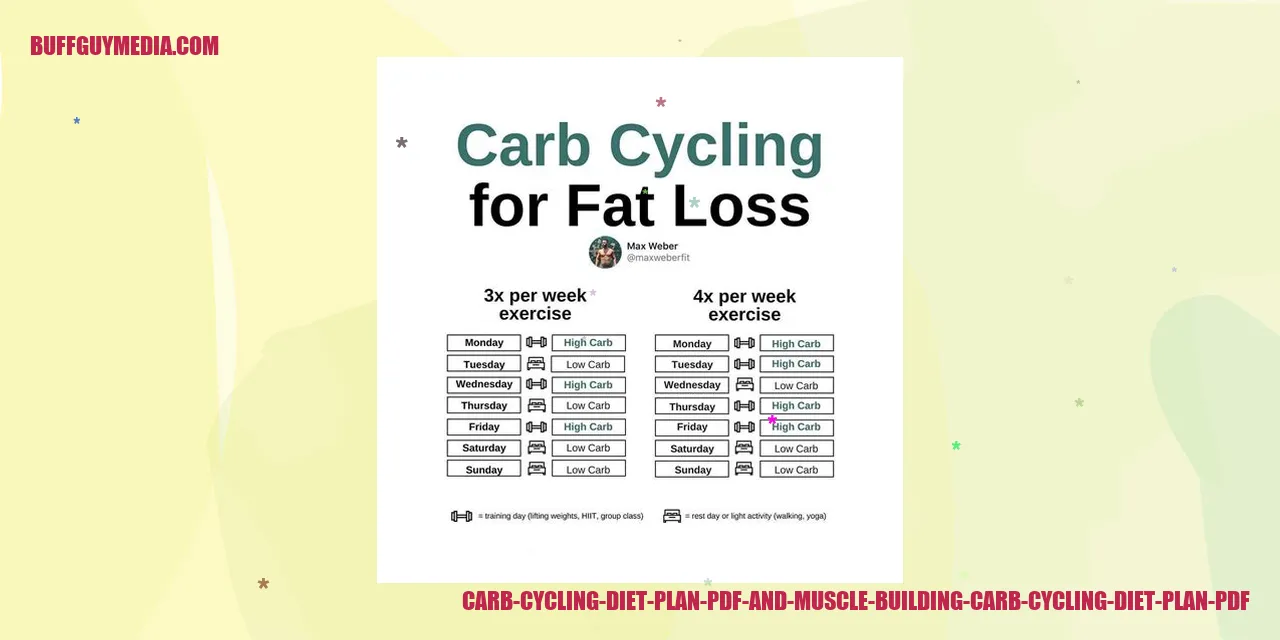
Carb Cycling Diet Plan: Boost your Muscle Growth
How can a carb cycling diet plan optimize muscle growth?
A carb cycling diet plan is a strategic nutritional approach that aims to enhance muscle growth and reduce fat accumulation. This diet plan involves alternating between high-carb days, moderate-carb days, and low-carb days, aligning carbohydrate intake with exercise demands and recovery requirements.
Dietary carbohydrates play a vital role in providing energy for physical activities. By adjusting carbohydrate consumption based on workout intensity and goals, individuals can maximize the benefits of their training sessions and promote muscle growth.
Adjusting a carb cycling diet plan for efficient muscle building
When it comes to muscle building on a carb cycling diet plan, it is essential to optimize the high-carb days. On these specific days, it is recommended to consume complex carbohydrates such as whole grains, fruits, and vegetables to fuel your workouts and replenish glycogen stores in your muscles.
Furthermore, prioritize adequate protein intake throughout the day to support muscle repair and growth. Include lean sources of protein such as poultry, fish, eggs, and legumes in your meals. Don’t forget to incorporate healthy fats from sources like avocados, nuts, and olive oil.
Effective workout routine for muscle building on a carb cycling diet plan
When pursuing muscle building while following a carb cycling diet plan, it is crucial to implement a well-rounded exercise routine that combines resistance training and cardiovascular activities.
Emphasize compound exercises that engage multiple muscle groups simultaneously, such as squats, deadlifts, bench presses, and rows. Gradually increase the weight or intensity of your workouts to ensure progressive overload and stimulate muscle growth.
Incorporating cardiovascular exercises like jogging or cycling on moderate-carb and low-carb days can aid in fat burning while preserving muscle mass.
Suggested supplements to enhance muscle building on a carb cycling diet plan
While a well-balanced diet should provide sufficient nutrients for muscle building, certain supplements can complement your progress on a carb cycling diet plan.
Consider incorporating protein powder into your diet, especially on low-carb days, to ensure you meet your protein needs. This can be particularly beneficial when it may be challenging to consume enough protein solely from whole foods.
In addition, creatine monohydrate is a renowned supplement known for its ability to enhance muscle strength and power. However, it is crucial to consult a healthcare professional before integrating any supplements into your routine.
By diligently following a carefully adjusted carb cycling diet plan, prioritizing protein intake, engaging in an effective workout routine, and considering suitable supplements, you can optimize your potential for muscle building and successfully achieve your fitness goals.

Unveiling the Impact of the Carb Cycling Diet Plan on Energy Levels
Key Strategies to Maintain Consistent Energy Levels on a Carb Cycling Diet Plan
The Carb Cycling Diet Plan has gained significant popularity among individuals seeking to optimize their energy levels and overall well-being by efficiently managing their carbohydrate intake. This dietary approach involves strategically alternating between high-carb and low-carb days to optimize energy levels while facilitating fat burning processes.
One of the primary effects of implementing a Carb Cycling Diet Plan is the potential to enhance performance during high-intensity workouts. By consuming a higher amount of carbohydrates on specific days, individuals can provide their bodies with the necessary fuel to sustain demanding exercise sessions. As a result, this can potentially lead to improved workout performance and sustained energy levels throughout the day.
However, maintaining stable energy levels is crucial on both high-carb and low-carb days. To achieve this, it is advisable to include complex carbohydrates in your meals, such as whole grains, legumes, and vegetables. These sources release energy gradually, ensuring a more sustainable energy supply and preventing sudden energy crashes.
Optimizing Carb Intake to Avoid Energy Crashes
Effectively adjusting carb intake is essential when following a Carb Cycling Diet Plan to avoid energy crashes. During low-carb days, it is important to replace the reduced carbohydrates with healthy fats and protein-rich foods. Incorporating foods such as avocados, nuts, lean meats, and dairy products during these days can help maintain satiety and sustained energy levels.
Conversely, on high-carb days, individuals can include healthy sources of carbohydrates like fruits, whole grains, and sweet potatoes. It is recommended to consume these carbohydrates before and after intense physical activities to replenish glycogen stores and support continuous energy levels.
Recognizing the Vital Role of Proper Hydration in a Carb Cycling Diet Plan
In addition to adjusting carbohydrate intake, maintaining proper hydration is of utmost importance when adhering to a Carb Cycling Diet Plan. Inadequate hydration can lead to depleted energy levels and hinder overall performance.
It is advised to aim for a daily intake of at least 8 glasses of water to ensure optimal hydration levels. This practice plays a critical role in promoting efficient bodily functions, including proper digestion, nutrient absorption, and sustainable energy production.
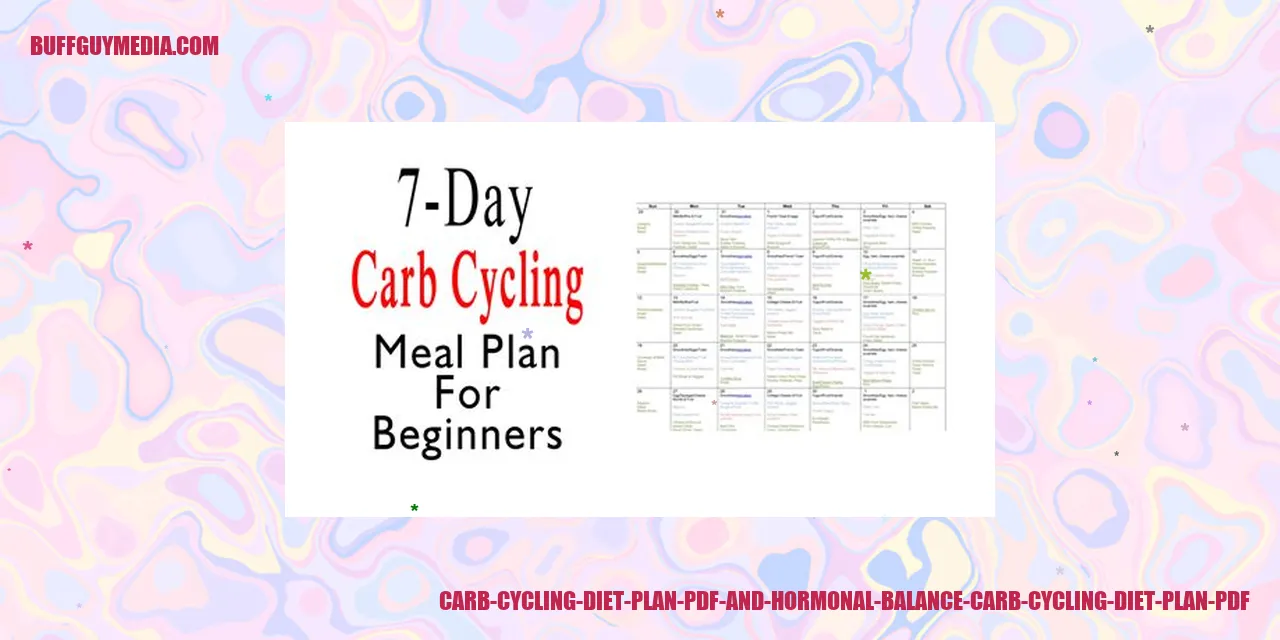
Understanding the Influence of a Carb Cycling Diet Plan on Hormone Levels
The Impact of a Carb Cycling Diet Plan on Hormonal Balance
A carb cycling diet plan is a nutrition strategy that alternates between high-carb and low-carb days. This dietary approach has a substantial impact on hormone levels within the body. One hormone that is significantly affected by carb cycling is insulin. On high-carb days, insulin levels increase to facilitate the absorption of glucose into the cells for energy production. Conversely, on low-carb days, insulin levels decrease, promoting fat burning and enhancing insulin sensitivity. This cyclical pattern aids in maintaining optimal hormone balance.
The Role of a Carb Cycling Diet Plan in Hormone Regulation
By incorporating a carb cycling diet plan, individuals can effectively regulate hormone levels. This approach promotes insulin sensitivity and prevents insulin resistance, which is crucial for maintaining hormonal equilibrium. Furthermore, carb cycling influences other hormones such as leptin and ghrelin, which play essential roles in appetite control. Additionally, this dietary pattern supports the production of vital hormones like testosterone and estrogen, benefiting both men and women.
Optimal Food Choices for Hormonal Balance on a Carb Cycling Diet Plan
Adopting a carb cycling diet plan for promoting hormonal balance requires selecting nutrient-dense foods. On high-carb days, prioritize complex carbohydrates like fruits, vegetables, whole grains, and legumes. These food choices provide essential vitamins, minerals, and dietary fiber that contribute to overall health and hormone balance. On low-carb days, emphasize protein-rich sources such as lean meats, fish, eggs, and dairy products. Incorporating healthy fats from avocados, olive oil, and nuts also helps sustain energy levels and supports hormonal functions.
The Significance of Stress Management in Conjunction with a Carb Cycling Diet Plan
Strategic stress management plays a vital role in the efficacy of a carb cycling diet plan and in maintaining optimal hormone balance. Chronic stress can disrupt hormone levels, resulting in imbalances and hindering progress. Integrating stress management techniques like mindfulness, meditation, regular exercise, and adequate sleep can help reduce cortisol levels, the primary stress hormone, and promote overall hormonal equilibrium. Prioritizing self-care and adopting healthy stress management practices are crucial components of achieving desired hormonal balance while following a carb cycling diet plan.

Understanding the Impact of Carb Cycling Diet Plan on Digestion and How to Maintain Optimal Digestive Health
Effects of a Carb Cycling Diet Plan on Digestion
Carb cycling diet plans have gained popularity as a method for managing weight and enhancing athletic performance. However, it is essential to consider the potential implications of this approach on digestive health.
One consequence of adopting a carb cycling diet plan is its influence on bowel movements. High carbohydrate days may lead to more frequent and softer stools due to increased starch and sugar intake, while low carbohydrate days can result in constipation and harder stools due to reduced fiber intake.
Moreover, individuals might experience temporary digestive discomfort, such as bloating, gas, or indigestion, as their carbohydrate consumption fluctuates. These symptoms typically improve as the body adapts to the diet plan.
Preventing Digestive Issues on a Carb Cycling Diet Plan
To minimize digestive problems while following a carb cycling diet plan, it is crucial to prioritize overall gastrointestinal well-being and make sound dietary choices.
Firstly, ensure that your diet comprises a balanced selection of whole foods. This will provide your body with essential nutrients, including fiber, which supports a healthy digestive system.
Secondly, gradually transition between high and low carbohydrate days instead of making sudden shifts. This gentler approach helps the body adapt more smoothly and reduces the likelihood of digestive discomfort.
Lastly, listen to the cues from your body and make adjustments as necessary. If particular foods cause digestive issues during specific phases of your carb cycling plan, consider reducing or eliminating their consumption to promote better digestion.
Recommended Fiber Intake on a Carb Cycling Diet Plan
Fiber plays a pivotal role in supporting digestion and maintaining overall gut health. However, since a carb cycling diet plan involves fluctuating carbohydrate intake, it is crucial to adjust fiber consumption accordingly.
On high carbohydrate days, it is advisable to incorporate fiber-rich foods, such as fruits, vegetables, legumes, and whole grains. These nutritious choices will supply essential nutrients and facilitate regular bowel movements.
On low carbohydrate days, focus on obtaining fiber from non-starchy vegetables, nuts, and seeds. Despite the lower carbohydrate intake, prioritizing fiber intake is still essential to prevent constipation and foster a healthy gut microbiome.
Supplements to Support Digestive Health on a Carb Cycling Diet Plan
While obtaining nutrients from whole foods is ideal, certain supplements can be beneficial in supporting digestive health while following a carb cycling diet plan.
Probiotics, for example, promote a healthy gut microbiome by supplying beneficial bacteria. Digestive enzymes can also aid in the breakdown and absorption of carbohydrates, particularly during high carbohydrate days.
However, it is crucial to consult with a healthcare professional or registered dietitian before incorporating any new supplements into your routine to ensure they align with your individual needs.
In conclusion, adopting a carb cycling diet plan can affect digestion, leading to changes in bowel movements and temporary digestive discomfort. However, by prioritizing gut health, gradually transitioning between carbohydrate levels, and adjusting fiber intake accordingly, these issues can be minimized. Additionally, incorporating supplements such as probiotics and digestive enzymes may support digestive health on a carb cycling diet plan. Remember to consult a healthcare professional to tailor the diet plan to your individual needs and goals.]
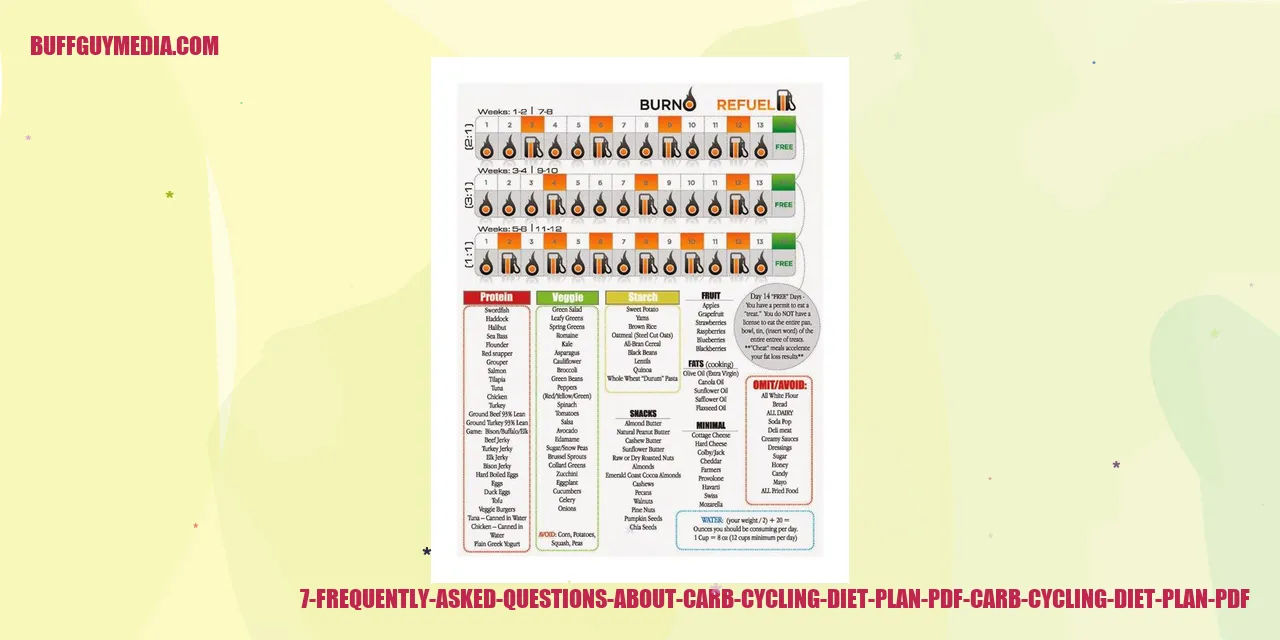
Everything You Need to Know about Carb Cycling Diet Plan
Who Can Benefit from a Carb Cycling Diet Plan?
A carb cycling diet plan is suitable for individuals of all fitness levels and goals. However, it is advisable to consult with a healthcare professional or a registered dietitian before embarking on any new dietary regimen, especially if you have underlying health conditions.
Is a Carb Cycling Diet Plan Suitable for Vegans or Vegetarians?
Yes, a carb cycling diet plan can be tailored to accommodate vegans or vegetarians. Instead of relying on animal-based protein sources, you can incorporate plant-based proteins like tofu, tempeh, legumes, and quinoa into your meals. It is important to ensure a diverse range of plant-based sources to meet all necessary nutrient requirements.
Can Treats and Cheat Meals be Included in a Carb Cycling Diet Plan?
Absolutely! Treats and cheat meals can be enjoyed in moderation while following a carb cycling diet plan. The key is to strategically include them during high-carb or refeed days to maintain a balance in macronutrients and overall calorie intake.
How Long Does It Take to See Results with a Carb Cycling Diet Plan?
The time required to witness visible results on a carb cycling diet plan varies from person to person. Factors such as individual metabolism, adherence to the plan, and consistent exercise routines can influence the rate of progress. Typically, noticeable changes in body composition and energy levels may occur within a few weeks of following the plan consistently.
Can a Carb Cycling Diet Plan be Combined with Other Eating Styles or Diets?
A carb cycling diet plan can be combined with other eating styles or diets, as long as it aligns with an individual’s specific goals and dietary needs. It is advisable to consult with a healthcare professional or a registered dietitian for personalized guidance and to ensure a balanced nutritional approach.
Are There any Health Risks Associated with a Carb Cycling Diet Plan?
Although a carb cycling diet plan can be beneficial for achieving certain fitness goals, it may not be suitable for everyone. Individuals with certain medical conditions, such as diabetes or eating disorders, should exercise caution and seek guidance from healthcare professionals. Monitoring the body’s response and ensuring adequate nutrient intake throughout the plan is essential.
Is Exercise Necessary during a Carb Cycling Diet Plan?
Regular exercise is recommended during a carb cycling diet plan to maximize its benefits. Physical activity helps boost metabolism, improve overall health, and enhance the effectiveness of the diet plan. Consider incorporating a combination of aerobic activities, strength training, and flexibility exercises for optimal results.


